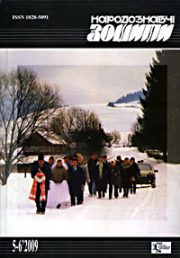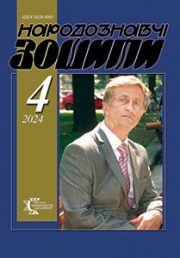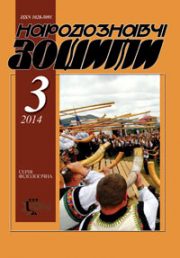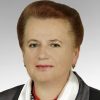The Ethnology Notebooks. 2025. № 5 (185), 1242—1249
UDK739(=1.23)(477.85/.87):94:008(477)
MASTERCLASS IN HUTSUL BRASS-WORKING AS A FORM OF PRESERVATION AND DEVELOPMENT OF ARTISTIC TRADITION
HORODETSKYI Vitalii
- ORCID ID: https://orcid.org/0000-0003-3283-3966
- Postgraduate Student, Vasyl Stefanyk Precarpathian
- National University, Department of Design and Art Theory,
- 57, Shevchenko Str., 76000, Ivano-Frankivsk, Ukraine,
- Contacts: e-mail: vitaliy.gorodetskiy@pnu.edu.ua
Abstract. Art-historical approaches to the preservation and development of the traditions of Hutsul metalwork through the conduct of master classes are investigated. The main attention is paid to the artistic transformation of archaic forms and ornaments in metal works of the early 21st century. The role of master classes as an effective form of transferring craft and creative knowledge, restoring ancient techniques, and forming artistic perception and cultural identity in participants is considered.
The purpose of the study is to provide an art-historical justification and study of the features , methods of conducting and the influence of master classes in metalwork on the development of the creative skills of the participants. The object of the study is the work of folk craftsmen and metal artists within the framework of master classes in the Hutsul region, held in 2024—2025, and the subject of the study is the author’s methods of conducting, creative techniques and educational effectiveness of the master classes.
The methodological basis of the study is an interdisciplinary approach that integrates art historical analysis of forms and ornaments of Hutsul metalwork, culturological understanding of the intangible heritage of Ukraine, as well as empirical methods — in particular, observation, comparative analysis and questionnaires of participants in master classes.
Keywords: brass-working, artistic metal, cultural heritage, Hutsul metalwork, masterclass, ornament, metal plastic arts, tradition, artistic transformation, identity, craft culture, cultural continuity, art education, innovations.
Received 25.09.2025
REFERENCES
- Ministry of Culture of Ukraine. National list of elements of intangible cultural heritage of Ukraine. Element: Hutsul brass art. Retrieved from: https://surl.li/tdlfra (Last accessed: 18.07.2025) [in Ukrainian].
- Chmil, H., Kuznietsova, I., Mishchenko, M., & Oliynyk, O. (2021). Intangible cultural heritage as a resource for consolidating modern Ukrainian society. Linguistics and Culture Review, 5, 747—760.
- Melnychuk, H. (2019). Contemporary forms of preservation and popularization of folk crafts (on the example of the Kosiv Museum of Folk Art and Life of Hutsulshchyna). Scientific Bulletin of Yuriy Fedkovych Chernivtsi National University, 2, 64—69. Retrieved from: https://surl.li/nogyim (Last accessed: 20.07.2025) [in Ukrainian].
- Hryhorieva, V.V., Ziakun, A.I., & Hutsul, I.A. (2024). The role of art education in shaping cultural identity and social integration: the experience of Ukraine and the world. Academic Visions, 35. Retrieved from: https://surl.li/vypfzy (Last accessed: 16.07.2025) [in Ukrainian].
- Frank, I. (2017). Hutsul neck ornaments in the context of preservation and development of folk traditions. The Ethnology notebooks, 5 (137), 1169—1172 [in Ukrainian].
- Bonkovska, S., & Pavliuk, S. (Ed.). (2006). Artistic metal. In: S. Pavliuk. Ethnogenesis and ethnic history of the population of the Ukrainian Carpathians (Vol. 2, pp. 727—751). Lviv: Institute of Ethnology [in Ukrainian].
- Horodetskyi, V. (2025). Traditions of Hutsul ornamentation in the context of experimental training in jewelry art. Hagenmeister Readings: 2024: Proceedings of the 4th International Scientific and Practical Conference (Pp. 92—93). Kamianets-Podilskyi: FOP Pankova A.S. [in Ukrainian].
- Kurylych, M. (2001). Hutsul ornament. Kyiv: LK Meiker; UVC [in Ukrainian].
- Stankevych, M. (2020). Ethnoaesthetics. Philosophy of folk art. Lviv: Union of Critics and Art Historians [in Ukrainian].
- Horodetskyi, V. (2024). Field materials recorded on 24.10.2024 from respondent O. Harkus (born 1973) [in Ukrainian].
- Horodetskyi, V. (2025). Field materials recorded on 25.06.2025 from respondent V. Martyshchuk (born 1974) [in Ukrainian].
- Without author. Tool for applying ornament (stylus «sikanets»). Museum of Ethnography and Arts and Crafts of the Institute of Ethnology of the National Academy of Sciences of Ukraine, Lviv. In. № EP18127 [in Ukrainian].
- Without author. Tool for applying ornament (stylus «patsiornyk»). Museum of Ethnography and Arts and Crafts of the Institute of Ethnology of the National Academy of Sciences of Ukraine, Lviv. In. № EP18134 [in Ukrainian].
- Without author. Tool for applying ornament (stylus «na kryzhyky»). Museum of Ethnography and Arts and Crafts of the Institute of Ethnology of the National Academy of Sciences of Ukraine, Lviv. In. № EP18135 [in Ukrainian].
- Without author. Tool for applying ornament (stylus «lystivnyk»). Museum of Ethnography and Arts and Crafts of the Institute of Ethnology of the National Academy of Sciences of Ukraine, Lviv. In. № EP18140 [in Ukrainian].
- Without author. Tool for applying ornament (stylus «duzhnychok»). Museum of Ethnography and Arts and Crafts of the Institute of Ethnology of the National Academy of Sciences of Ukraine, Lviv. In. № EP18147 [in Ukrainian].
- Sukha, L. (1959). Artistic metal works of Ukrainians of the Eastern Carpathians of the second half of the 19th—20th centuries. Kyiv [in Ukrainian].
- Horodetskyi, V. (2025). Field materials recorded on 25.06.2025 from respondent I. Shkondeiuk (born 1982) [in Ukrainian].
- Horodetskyi, V. (2025). Field materials recorded on 25.06.2025 from respondent N. Haborak (born 1986) [in Ukrainian].







